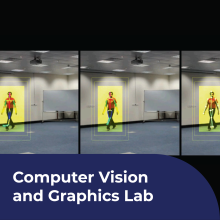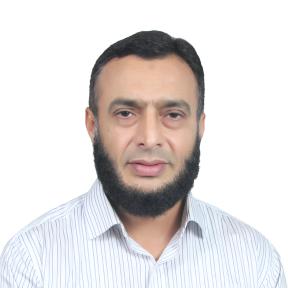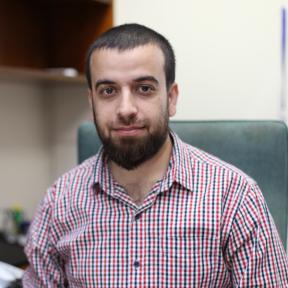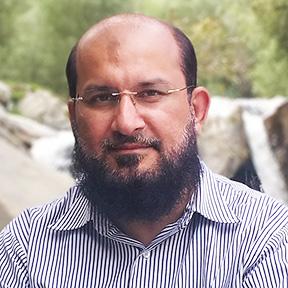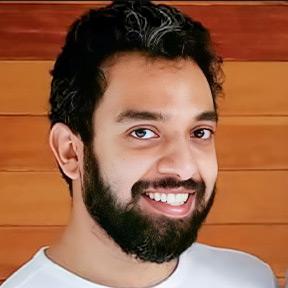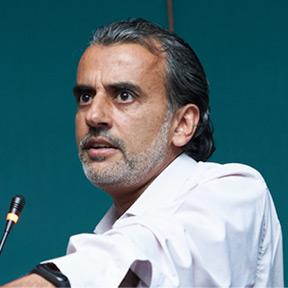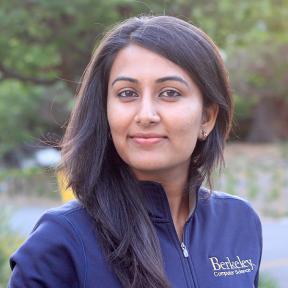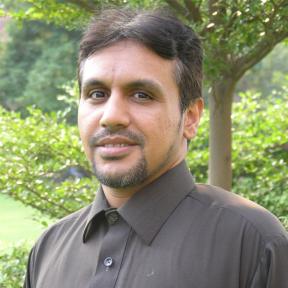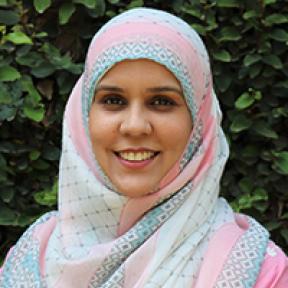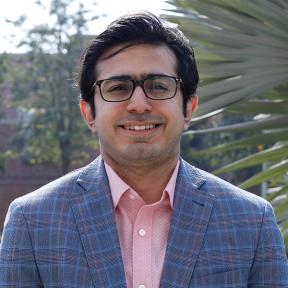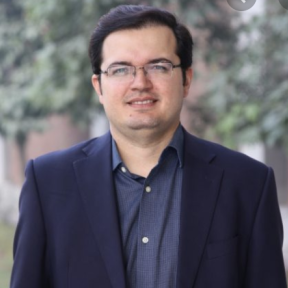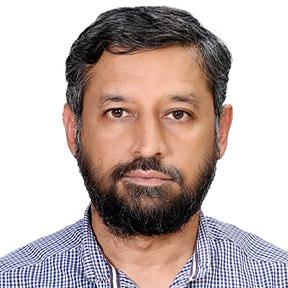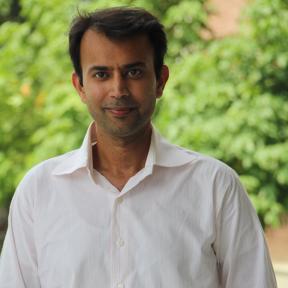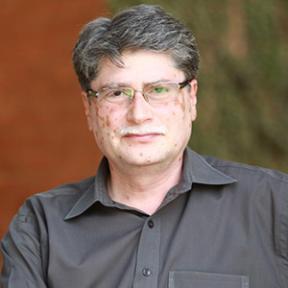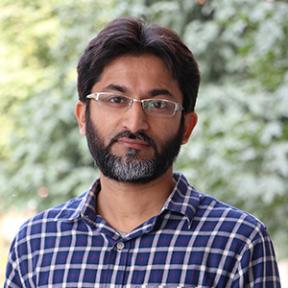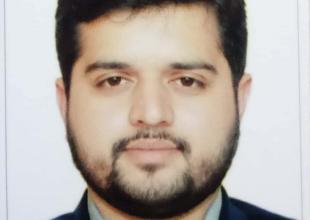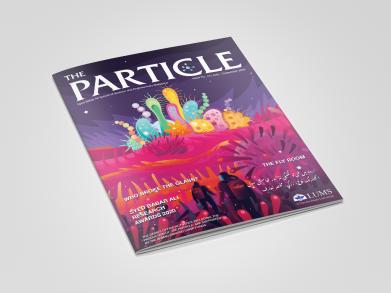The Department of Computer Science at LUMS offers a rigorous undergraduate education. Our goal is to deliver CS education that is at par or better than the world’s finest educational institutions. Our program not only prepares our students for careers in leading companies but also in carrying our world-class research. LUMS CS students have been consistently placed in leading companies across the world including Google, Microsoft, Facebook, and Amazon and receive fully-funded graduate admission offers from the most prestigious universities in the world including MIT, Stanford University, UC Berkeley, CMU, UIUC, UT Austin and many others. For the last many years we have had 100% success rate for graduate admissions and job placements. As CS education is important in many other disciplines, we believe in imparting broad-based education to our students. Thus, in addition to CS courses, the students could take as many as ten courses from other departments including Management, Economics, Law, Biology, Mathematics and others, thus broadening their horizon in multiple disciplines.
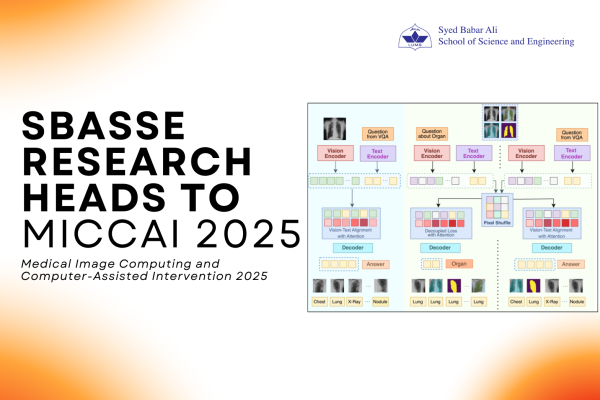
We are pleased to share that two research papers from the Syed Babar Ali School of Science and…
We are pleased to share that two research papers from the Syed Babar Ali School of Science and Engineering (SBASSE), LUMS, have been accepted for presentation at the 28th International Conference on Medical Image Computing and Computer-Assisted Intervention (MICCAI 2025).
MICCAI 2025 will take place from September 23–27, 2025, at the Daejeon Convention Center in South Korea, a city celebrated as the “Silicon Valley of Korea” and a hub for science and innovation. MICCAI is widely regarded as a leading global platform in the domains of medical image computing and AI-assisted healthcare technologies. Ranked ‘A’ by the CORE conference rankings, this year’s conference received a record 3,677 submissions, which is 28% more than last year. Of these, 3,447 papers underwent peer review, with only 1,014 accepted, reflecting a highly competitive 29% acceptance rate.
Both accepted papers were developed as part of MS thesis projects under the supervision of Dr. Murtaza Taj, Associate Professor in the Department of Computer Science at SBASSE, LUMS. The work highlights SBASSE’s continued emphasis on mentorship, interdisciplinary collaboration, and impactful research in emerging areas of science and technology.
1. CATVis: Context-Aware Thought Visualization
This paper investigates how the cognitive process of interpreting medical images can be visualized, offering new possibilities for training and diagnostic support in clinical environments.
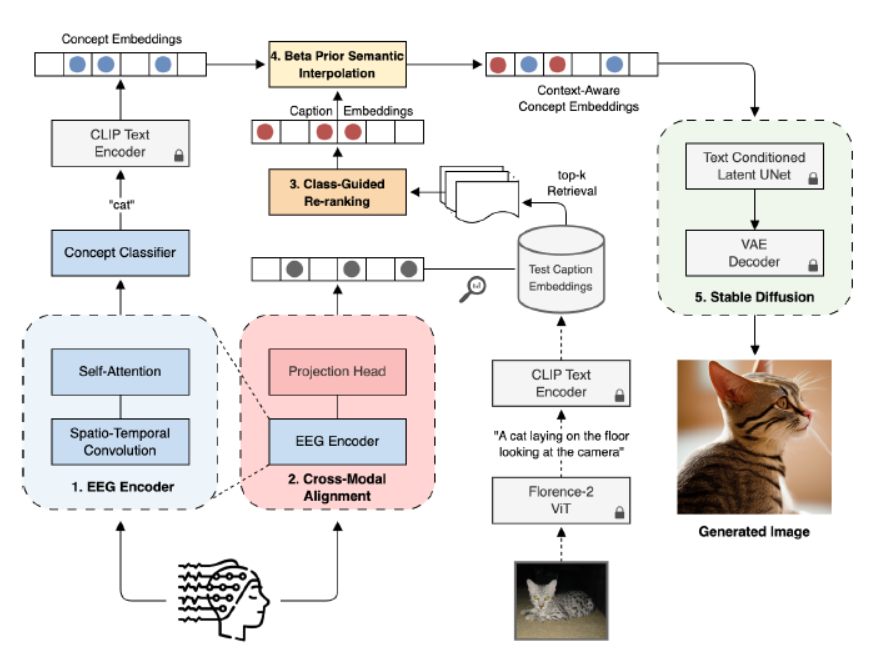
Authors: Hamza Ahmad (Undergrad. – FCCU, Founding AI Eng. – Uplift AI), Tariq Mehmood (MSCS, LUMS), Dr. Muhammad Haroon Shakeel (Arbisoft, PhD LUMS), Dr. Murtaza Taj (LUMS)
Hamza and Tariq contributed equally to this research.
2. Localization Lens for Improving Medical Vision-Language Models
The second study introduces a localization-based framework to enhance the performance and interpretability of AI models that combine visual and textual data in medical imaging.
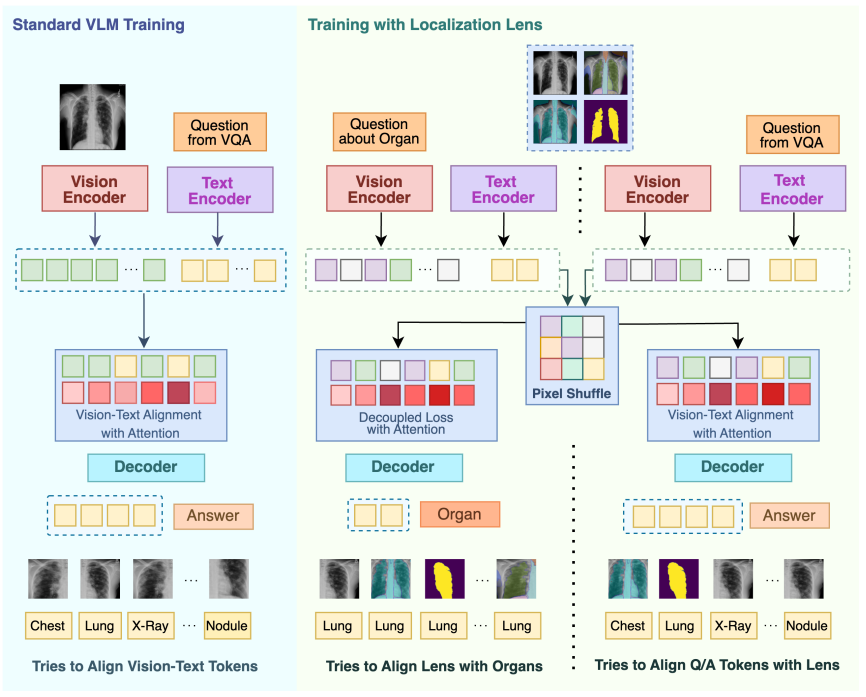
training utilizing localization lens.
Authors: Hasan Farooq (MSCS, LUMS), Dr. Murtaza Taj (LUMS), Dr. Mehwish Nasim (University of Western Australia), Dr. Arif Mehmood (ITU)
These recognitions are a testament to the quality of research training at SBASSE, and the global relevance of the scientific questions explored by its students and faculty.
Congratulations to all authors and collaborators on this remarkable achievement.
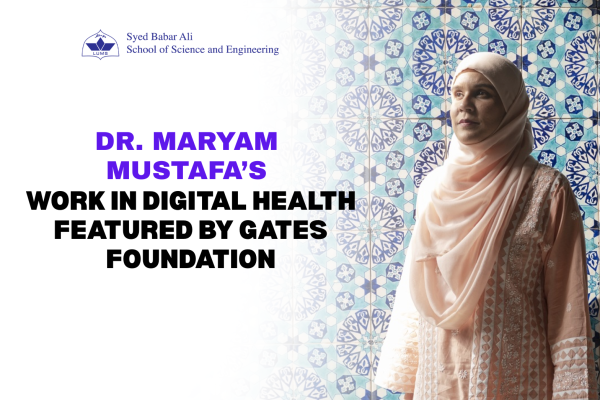
Dr. Maryam Mustafa, Assistant Professor at the Department of Computer…
Dr. Maryam Mustafa, Assistant Professor at the Department of Computer Science, Co-founder Awaaz-e-Sehat and Director of the Saida Waheed Gender Initiative at LUMS, has been featured by the Bill & Melinda Gates Foundation for her work in digital health, particularly her efforts to support maternal care through contextually relevant technology.
The feature highlights Awaaz-e-Sehat, an AI-powered, voice-enabled record management and diagnostic support system developed to assist frontline health workers in Pakistan. The system is designed to make digital tools more accessible in settings with limited literacy and infrastructure, allowing community health providers to record and retrieve patient data using voice input in local languages. The system also supports health care workers by providing diagnostic support so patients receive timely interventions and care.
Dr. Maryam and her team have worked closely with public health experts and community partners to co-design the platform, ensuring that the technology aligns with on-the-ground realities. The project focuses on improving continuity of care, supporting health workers in following up with patients, and contributing to more organized and reliable maternal health records.
Earlier, Dr. Maryam received the Grand Challenges: Catalyzing Equitable Artificial Intelligence (AI) Use award from the Gates Foundation in support of this initiative. More recently, she was awarded the Google Award for Academic Research 2024, and The Patrick J. McGovern award which recognizes her contributions to inclusive and equitable AI development in healthcare settings.
The full article by the Gates Foundation can be accessed here.
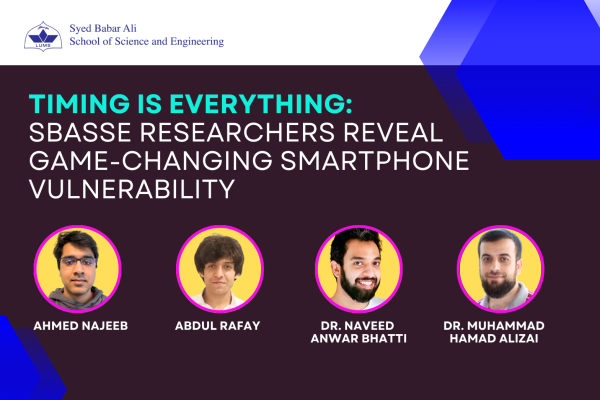
In a world where security is paramount, the ability to protect…
In a world where security is paramount, the ability to protect personal information is constantly evolving. At SBASSE, a team of talented computer science researchers has uncovered a vulnerability in smartphone technology that could change the way we think about privacy.
The paper, "Glitch in Time: Exploiting Temporal Misalignment of IMU for Eavesdropping," has just been accepted to AsiaCCS 2025 (Core Rank A), a prestigious conference in the field of cybersecurity. With a competitive acceptance rate of only 15% in Cycle 1, this marks a significant achievement for the team, composed of Dr. Naveed Anwar Bhatti, Ahmed Najeeb, Abdul Rafay, and Dr. Muhammad Hamad Alizai.
What began as a simple class project for CS 677 in 2023 quickly turned into a journey of discovery. Ahmed and Abdul, both passionate about technology, set out to replicate existing research aimed at reconstructing audio from mobile accelerometer data. Their breakthrough came when they introduced a clever twist—misaligning the timing between the smartphone’s gyroscope and accelerometer. This allowed the gyroscope data to enhance the accelerometer data, making it possible to reconstruct voice commands at a lower sampling rate, all without requiring user permissions.
This discovery has profound implications for smartphone security. The ability to "listen" to your voice assistant commands without consent—using just two sensors at a sampling rate as low as 200 Hz—poses a major privacy risk. The vulnerability comes from the fact that these sensors don’t require user permission to operate at low rates, making them an ideal target for exploitation.
After months of hard work, the project blossomed into a senior-year SProj and was submitted to AsiaCCS 2025 in August 2024. The team's work has now earned them a place in one of the world’s top cybersecurity forums, where their research will undoubtedly inspire further innovations.
Dr. Naveed shares his pride, saying, “We can’t help but feel proud of Ahmed and Abdul, who poured their heart and soul into this project.”
Ahmed, now pursuing his PhD at Rochester Institute of Technology (RIT), and Abdul Rafay, who is continuing his academic journey as a Teaching Fellow in CS at LUMS, have “both proven that with dedication and creativity, the boundaries of what is possible in technology can be pushed even further.”
Congratulations to the team on their groundbreaking success!
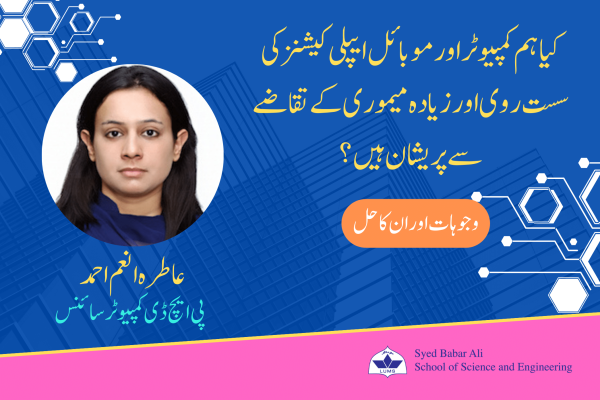
لمز سکول آف سائنس اینڈ انجینیئرنگ میں پی ایچ ڈی کمپیوٹر …
لمز سکول آف سائنس اینڈ انجینیئرنگ میں پی ایچ ڈی کمپیوٹر سائنس کی طالبہ عاطرہ انعم احمد کی شاندار تحقیق ، جو اس پریشانی کا حل تلاش کرنے میں معاونت فراہم کرتی ہے۔ عاطرہ نےحال ہی میں قابلِ تحسین تحقیقی نتائج کی بنیاد پر اپنے فائنل تھیسز کا کامیاب دفاع کیا۔
ہم جانتے ہیں کہ کمپیوٹرز ہارڈویئر اور سافٹ ویئر کا امتزاج ہیں ۔لیکن سافٹ ویئر انجینئرنگ1 کے مروجہ طریقے( جیسے کوڈ کا دوبارہ استعمال اور یکسانیت) سافٹ ویئر کے سائز ،پیچیدگی ، حفاظتی کمزوریوں اور خرابیوں کے امکانات میں نمایاں اضافہ کردیتے ہیں ۔ مزید برآں یہ طریقے سافٹ ویئر کی کارکردگی اور وثوق کوبھی کم کرتے ہیں۔ یہ صورتحال سافٹ ویئر بلوٹ2 کے مسئلے کا بنیادی سبب ہے، جو میموری3 میں وسائل کے ضیاع کا باعث بھی ہے۔
سافٹ ویئر بلوٹنگ کے عارضے کے تدارک کے لیے موجود ہ متعدد جدید ترین طریقہ کار کو بادی النظر میں دو گروہوں میں تقسیم کیا جا سکتا ہے۔ ایک وہ جنھیں تحریری طور پر اعلیٰ سطحی تفصیلی تصریحات مثلاً ٹیسٹ کیسز 4 کی ضرورت ہوتی ہے ۔ یہ طریقہ کار صارفین کے لیے بوجھل اور غیر موزوں ہو سکتے ہیں۔ دوسرے وہ طریقےہیں جو تشکیلاتی معلومات 5 واضح کرنے کے لیے سطر الامر دلائل (کمانڈ لائن آرگیومنٹس6 ) کا استعمال کرتے ہیں۔ ان کوایپلی کیشن کے کوڈ میں مستقل 7 کے طور پر پھیلاتے ہیں اورڈیڈ کوڈ کو حذف کرتے ہیں جو مستقلات موجود ہونے پر عمل میں نہیں آتا ہے ۔
اس کےپیش نظر عاطرہ کی تحقیق مندرجہ ذیل نکات پر مرکوز ہے:
اول:تحقیق میں یہ استدلال کیا گیا ہے کہ جدید ٹولز میں استعمال ہونے والے طریقہ کار، ڈیڈ کوڈ کے خاتمے کے معاملے میں غیر موثر ہیں ۔ کیونکہ وہ سیاق و سباق سے بے نیاز ہو کر کوڈ میں مستقل کو پھیلا دیتے ہیں۔ لہذا عاطرہ کے کام میں سیاق و سباق کی حساسیت پر مبنی خفیف مستقل پھیلاؤ 8 متعارف کرایا گیا ، جو صرف تشکیلاتی معلومات کے حامل متغیرات کے لیے مستقلات کی افزائش کرتا ہے ۔
دوم: جدید ٹولز جامد تشکیلاتی فائل9 سے قطع نظر یا توصرف سطر الامر دلائل10 پر انحصار کرتے ہیں یاایسی فائل سے نمٹنے کے لیے دستکارانہ طریقہ فراہم کرتے ہیں۔ اس مسئلے کو حل کرنے کے لیے خودکار فائل آئی /او تخصص11 کی تجویز پیش کی گئی ، یعنی، فائل میں جامد تشکیلاتی معلومات کوڈ میں مستقل کے طور پر اٹھائی جائے۔ یہ طریقہ کار فائل کا تجزیہ کرنے والے کوڈ کو آسان بناتا ہے اور ڈید کوڈ کو حذف کر دیتا ہے ۔
سوم: خود کار انداز سے کوڈ سائز میں کمی کے سلسلے میں تخصص کے فوائد دینے والےافعال کی نشاندہی کے لیےڈیپ لرننگ کے طریقے12 تجویز کیے گئے ہیں۔اس ضمن میں تخصص سے وابستہ افعال کی دو اقسام پر مبنی ایک تربیتی ڈیٹاسیٹ13 تیار کیا جائے گا ۔ صارف اپنے ماڈل کو اس ڈیٹاسیٹ پر تربیت دے کر ایپلی کیشنز میں قابل تخصیص اورنا قابل تخصیص افعال کی پیش گوئی کر سکیں گے۔
عاطرہ نے ٹرمر 14 پر سیاق و سباق کی خفیف حساسیت اور فائل آئی / او تخصص کو نافذ کیا ۔ انھوں نے 20 لینکس یوٹیلیٹیز 15 (بشمول جامد تشکیلاتی فائلز کے متقاضی چھے بینچ مارکس)پر اپنی مجوزہ سفارشات کو پرکھا ۔ یہ سفارشات ،سیاق و سباق کی حساسیت اور غیر حساسیت کے مقابلے میں، مشترکہ حفاظتی خطرات کو دور کرنے کے ساتھ ساتھ کوڈ کے سائز میں اوسطاً زیادہ کمی فراہم کرتی ہیں ۔
عاطرہ کے نزدیک پی ایچ ڈی آسان نہیں۔ یہ منصوبہ وقت طلب ہے۔ یہ صرف محنت یا ذہانت نہیں ہے بلکہ یہ کثیر تبادلہ خیال، مستقل مزاجی، وجوہات کی کھوج میں طویل اوقات کام کرنے، دباؤ محسوس کرنے، کئی بار ناکام ہونے اور دوبارہ کھڑے ہونے کے بارے میں ہے۔ بعض اوقات، آپ کو اپنی ذاتی ترجیحات، خاندان اور دوستوں کو نظر اندازبھی کرنا پڑتا ہے۔ الغرض صورت حال کچھ بھی ہو، اس سفر میں ثابت قدمی اور انتہائی بلند حوصلے کی ضرورت ہوتی ہے۔ وہ اپنے اس کامیاب سفر کے لیے لمز سکول آف سائنس اینڈ انجینیئرنگ کےقابل اساتذہ ، معاون عملے اور حوصلہ افزا ساتھیوں کی تہہ دل سے مشکور ہیں۔ آج کل عاطرہ ایک پرائیوٹ یونیورسٹی میں لیکچرار کی خدمات سرانجام دے رہی ہیں ۔ وہ مستقبل میں شعبہ تعلیم سے وابستہ رہنے اور معیاری تحقیق شائع کرنے کی متمنی ہیں۔
- Software Engineering
- Software Bloat
- Computer Memory
- Test Cases
- Configuration Information
- Command-Line Arguments
- Constant
- Sparse Constant Propagation
- Static Configuration File
- Command Line Arguments
- Automated File I/O Specialization
- Deep Learning
- Training Dataset
- TRIMMER - a configuration-driven code debloating tool
- Linux Utilities

From 9th to 12th August 2025, the Syed Babar Ali School of Science and Engineering (SBASSE) hosted the fifth edition of the LUMS Science Symposium (LSS), welcoming over 500 high school students from across Pakistan. Organised by SPADES, the student-led science society at LUMS, the symposium has grown into a landmark event that helps young learners take their first confident steps into research and discovery.
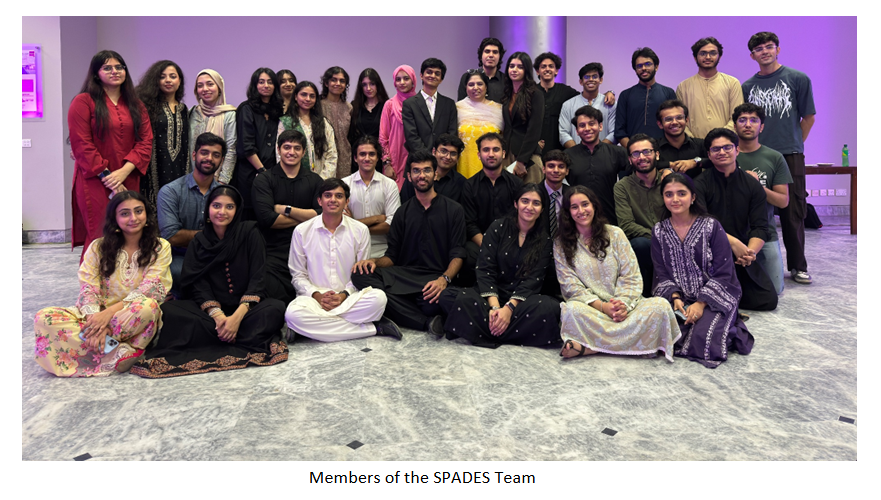
This year’s edition, convened by Kiswah Saboor and Wasay Rafaqat, offered four academic streams: AI/ML, Life Sciences, Autonomous Systems, and Quantum Computing. Each guided by SPADES stream leads and mentors from LUMS and beyond. Delegates worked closely with them to design projects and research papers, with the best submissions celebrated at the closing ceremony.
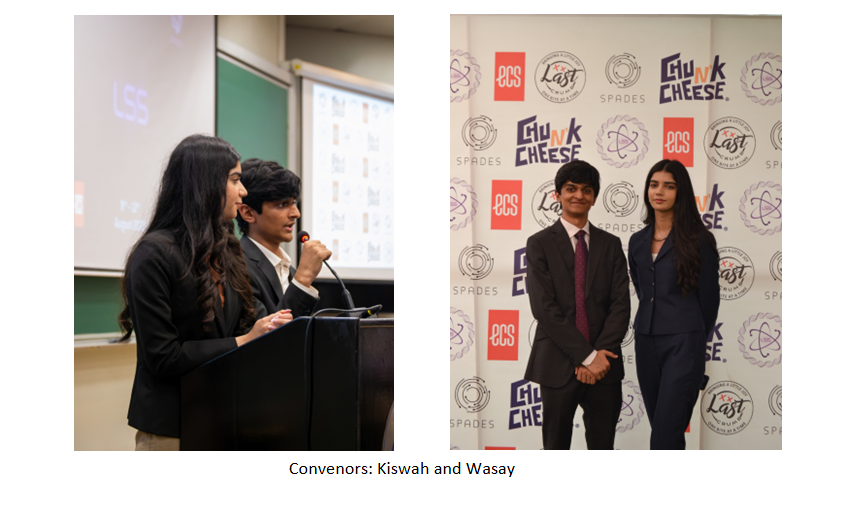
The Life Sciences stream delved into artificial organs, CRISPR, and bioethics debates, while Autonomous Systems focused on Arduino programming and agricultural prototypes. Quantum Computing introduced delegates to quantum gates, cryptography, and hardware with lectures by faculty experts, and AI/ML progressed from coding challenges to neural networks and no-code tools.
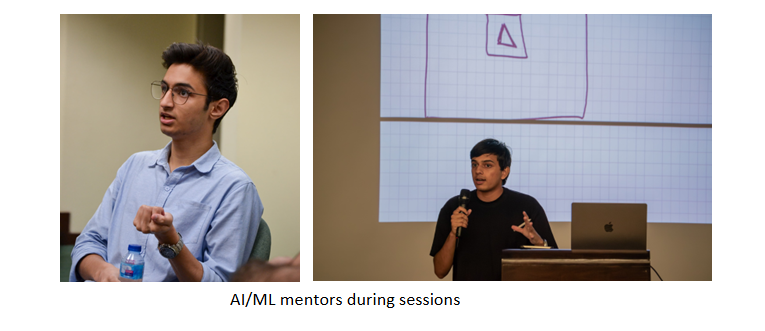
For the first time, a Women in STEM round was launched, led by Roshanay Fatima and Wardah Rasheed. In a Shark Tank–style competition, delegates proposed STEM-based solutions to challenges in FemTech, Domestic Safety, and Financial Empowerment, culminating in impactful pitches on Day 4.
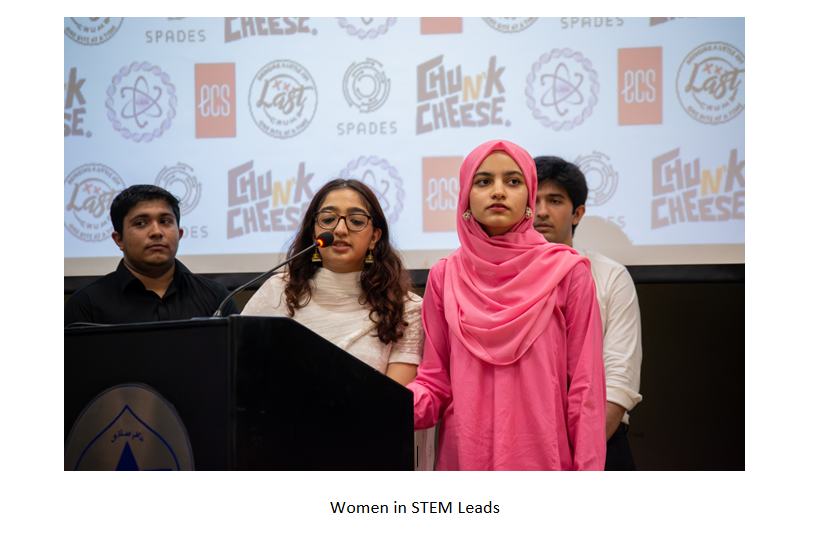
The symposium also featured a cultural first: LSS Social, Qawali Night, adding celebration to four days of intense learning.
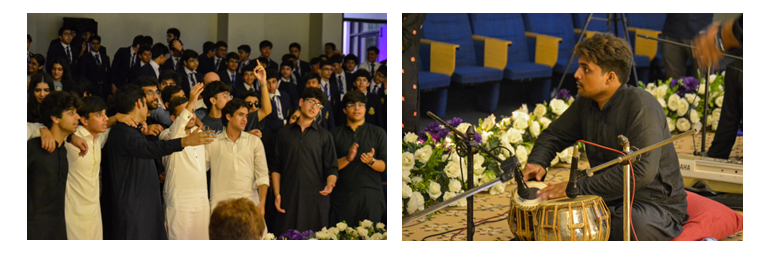
Closing the event, Dean Dr. Walther Schwarzacher commended the delegates for their creativity and curiosity, marking the symposium as not just a competition, but a starting point for future innovators.
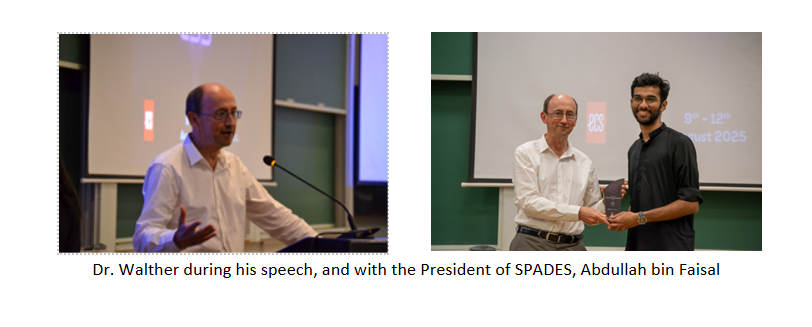
From 9th to 12th August 2025, the Syed Babar Ali School of Science and Engineering (SBASSE) hosted the fifth edition of…
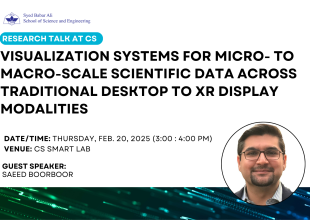
Saeed Boorboor is currently a Principal Research Scientist at the Center for Visual Computing at Stony Brook University, and is joining the University of Illinois Chicago as an Assistant Professor starting Fall 2025. He received my BS in Computer Science from the School of Science and Engineering, LUMS, Pakistan, and his Ph.D. in Computer Science from Stony Brook University, NY. His research seeks to design, build, and evaluate visualization systems that empower domain scientists to explore, analyze, and interact with scientific data, using methods of human-centered design, image processing, computer graphics, and applied AI. He is also interested in investigating novel visualization and interaction methods across immersive technologies -- from hand-held and wearable devices to large display modalities.
Saeed Boorboor is currently a Principal Research Scientist at the Center for Visual Computing at Stony Brook University, and is joining the University of Illinois Chicago as an Assistant Professor starting Fall 2025.
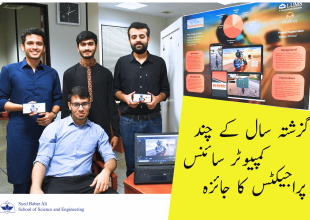
نصابی تعلیمات کو صنعت سے جوڑنے کے لیے لمز کی انڈرگریجویٹ تعلیم کے آخری سال میں ایک پروجیکٹ پر کام کرنا ہوتا ہے۔ عام طور پریہ دو سمسٹرس پرمشتمل ہوتا ہے لیکن اگر پروجیکٹ نامکمّل رہ جائے تواس سے زیادہ وقت بھی لگ سکتا ہے۔ کمپیوٹر سائنس کے طلباء نے اس سال اپنے نگران، پروفیسر وقار احمد کے ساتھ بہت دلچسپ پروجیکٹس پر کام کیا ،جن کا سب سے بڑا مقصد صنعتی معیارسے ہم آہنگ سافٹ ویئر تخلیق کرنا تھا۔ طلباء نے چار سے پانچ افراد پر مشتمل 3 گروپوں میں اپنے عنوانات پر سوچ بچار شروع کی۔ انہوں نے اپنے خیالات وقار صاحب کے سامنے پیش کیے جنہوں نے ان کی رہنمائی کی اور انکے خیالات کو مزید نکھارا۔ پروجیکٹس کی تکمیل کے بعد طلباء نے سامعین کے سامنے اپنا کام پیش کیا اور انفرادی طور پرپروجیکٹ میں اپنے اپنے کردار کے بارے میں معلومات فراہم کیں۔
ایک گروپ نے مشہور زمانہ موبائل گیم سبوے سرفرز (١) کے طرز کی گیم بنائی۔ ان کا کہنا تھا کہ گیم ڈویلپمنٹ (٢) کے موضوع پر لمز میں نہ ہی کوئی کورس پڑھایا جاتا ہے اور نہ ہمارا اس ابھرتی ہوئی صنعت کی طرف کچھ خاص رجحان ہے۔ ان کے خیال میں اس پر کام کرنا اپنی جگہ دشوار تو تھا کیوںکہ کافی تصورات انکے لیے نئےتھے، لیکن اسی وجہ سے انہیں کافی کچھ سیکھنے کو ملا اور ان کا پروجیکٹ اپنی جگہ ممتاز ٹھہرا۔ اس پروجیکٹ میں ماینڈ سٹارم اسٹوڈیوز (٣) نے بھی طلباء کو پیشہ ورانہ مدد فراہم کی۔
ایک دوسرے گروپ نے ایک ایسی اپلیکیشن بنائی جو سوشل میڈیا انفلونسرز سے رابطے کو آسان اور آٹومیٹک بنا دیتی ہے۔ مزید براں تیسرے اورآخری گروپ نے ایک خود مختار تجارتی بوٹ بنایا جس پہ اب ہم تفصیل سے بات کریں گے۔
جیسا کہ ہمیں معلوم ہے دنیا بھر میں تجارت کے لیے مختلف ایکسچینجز ہیں جیسے نیس ڈیک (٤) وغیرہ۔ اب تجارت میں کچھ خاص خاکے ہوتے ہیں اور اسی بنا پر اسٹاکس کی قیمتوں میں کمی یا اضافہ دیکھنے کو ملتا ہے۔ اگر ان خاکوں کو قواعد کے مجموعہ میں ڈال کر حساب کیا جائے تو اسے ایک بوٹ کے ذریے کنٹرول کرنا ممکن ہوجاتا ہے۔ اس سے تجارت کا عمل خود مختار ہو جاتا ہےاور زیادہ مؤثر اور منافع بخش بھی بن جاتا ہے کیونکہ بظاھر بوٹس انسانی دماغ سے زیادہ ڈیٹا ذخیرہ کرنے کی صلاحیت رکھتے ہیں اور اس ڈیٹا کے مطابق کیے گئے فیصلوں کے درست ہونے کا امکان بھی زیادہ ہوتا ہے۔ اس کے علاوہ کسی انسان کا دن کے چوبیس گھنٹے کمپیوٹر کے سامنے بیٹھنا اور ترمیمی طریقے کے مطابق فیصلے کرنا ناممکن ہے جبکہ بوٹس کے ذریے یہ کام ہمہ وقت لیا جاسکتا ہے۔ دنیا کی مختلف ایکسچینجز کے لیے یہ بوٹس اب دستیاب ہیں اوراستعمال بھی ہو رہے ہیں لیکن پاکستان اسٹاک ایکسچینج (پی ایس ایکس) کے لیے ایسا کوئی آلہ موجود نہیں۔
تیسرے گروپ نے اسی خلا کو پر کرنے کی کوشش کی اور پی ایس ایکس کے لیے ایک تجارتی بوٹ تخلیق کیا۔ انہوں نے پچھلے دو ماہ کا ڈیٹا حاصل کیا اور اس سے 15 دن بعد ہونے والی اسٹاک کی قیمتوں کی کامیاب پیشن گوئی کی۔اس سافٹ ویئر کی خوبصورت بات یہ ہے کے اسے بدلنا اور دوسرے ایکسچینجز یا سسٹمز پر ڈھالنا نہایت سہل ہے۔ فی الحال اسے پی ایس ایکس پر بنایا ہے لیکن اس کو بدل کرنیس ڈیک حتیٰ کے کرپٹو ایکسچینجزپر بھی بدلا جا سکتا ہے۔
ایک عام آدمی کا اسٹاک ایکسچینج پر تجارت کرنا اور اسے سمجھنا کافی دشوار ہے۔ اس بوٹ کا ایک اور فائدہ یہ ہے کہ اس کے ذریعے اسٹاکس کی پیچیدہ منطق کوخودکارکر دیا جاتا ہے اور صارف کو ایک آسان انٹرفیس(٥) فراہم کیا جاتا ہے۔ اپنے پروجیکٹ کے لیے اس گروپ نے بزنس اسکول کے طلبا اور پروفیسر سر کمیل کے ساتھ بھی اشتراک کیا۔
تمام گروپس اپنے سپروائزر سر وقار سے خوش تھے اور ان کا کہنا تھا کہ یہ ایک نہایت مفید اور یادگار تجربہ رہا۔
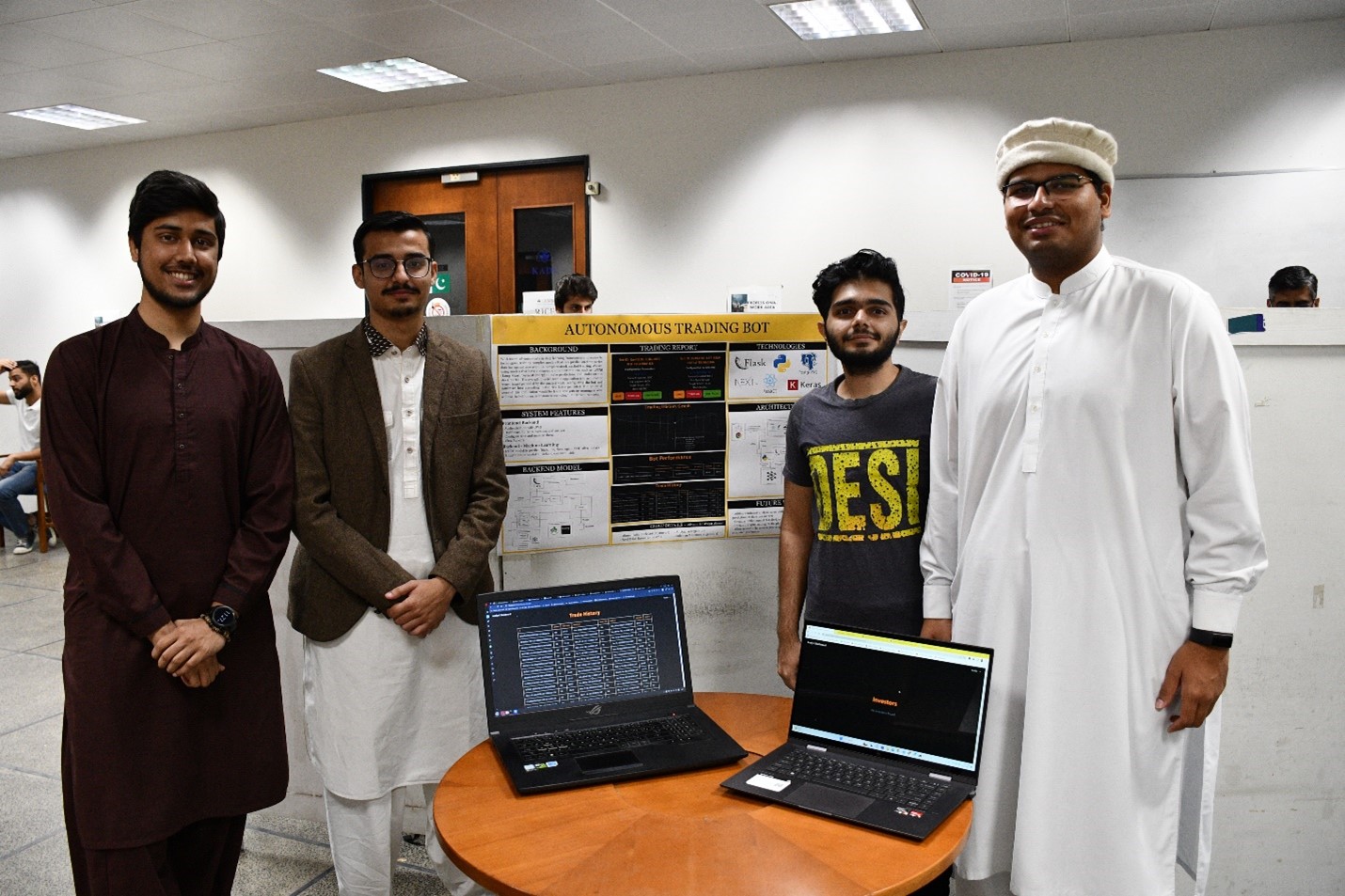
(1) Subway Surfers
(2) Game development
(3) Mind Storm Studios
(4) NASDAQ
(5) Interface

نصابی تعلیمات کو صنعت سے جوڑنے کے لیے لمز کی انڈرگریجویٹ تعلیم کے آخری سال میں ایک پروجیکٹ پر کام کرنا ہوتا ہے۔ عام طور…

